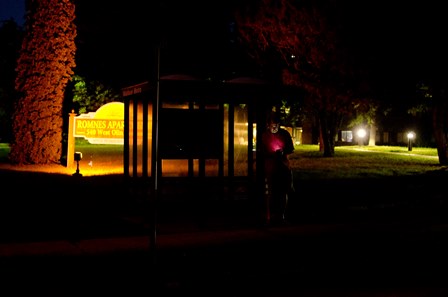






The Bus Stops Here is produced monthly by members of the Madison Area Bus Advocates.
“The first priority should be maintaining and improving personal safety on buses and at bus stops” -- Page 9 of the 2008 Final Report of the City of Madison Long-Range Metro Transit Planning Ad Hoc Committee.
"Improving lighting at bus stops is one of the top...ways to improve transit safety and security” -- From Lighting at Bus Stops by Christopher MacKechnie.
Lighting increases safety because people can see nefarious behavior and car drivers can see and avoid hitting pedestrians. Indeed, many pedestrians and bicyclists wear reflective clothing or small battery-operated lights during the winter or at night to increase their visibility in the dark, using just that kind of reasoning.
When bus stops are located to take advantage of overhead lighting from city street lights, no extra power source is needed; the lighting costs nothing extra. Judicious stop placement can be a frugal enterprise of incredible value to the bus rider.
 The Olin @ Whittier bus stop near South Park (Julia Levine)
The Olin @ Whittier bus stop near South Park (Julia Levine)
Given its latitude, there are months of short days in Madison. Between March 21 and September 21 daylight might fluctuate between about 12 and 15 hours, but during the other six months it fluctuates between 12 and 9 hours. On the longest day of the year, the sun may rise before 5:30 a.m. and set after 8:30 p.m. On the shortest day of the year it may not rise until close to 7:30 a.m. and sets before 4:30 in the afternoon. On the shortest days, many bus riders spend morning and afternoon hours in the dark at their stops even when staying indoors later in the morning and fairly early in the evening. If they want to participate in events that occur after daytime work hours at any time of the year, they inevitably travel in the dark.
Consistent with concern about lighting, one of the features Metro keeps track of in its inventories of bus stops is whether the bus stop has access to lighting and what the source is of that lighting (transit agency, external jurisdiction, public institution etc.).
That is why it seemed so curious – but unfortunately far too common – that in the following example, bus stop lighting was not given the priority most bus users would consider fundamental. Roughly two years ago, there had been a bus stop under a street light at the intersection of Spaanem Avenue and Buckeye Road. There was no shelter or bench there, but at least the stop’s location provided some sense of safety as cars often used Buckeye Road, and a passing driver would see if anything were amiss using light from the street lamp. A nearby bus stop near Turner Avenue, though also on Buckeye Road, was not under a light and thus was much less visible to passing traffic. Metro decided that it did not need to maintain both stops. So guess which stop was taken away forever and which stop remained?
If you guessed that the lighted stop by a busy road was retained, you would be wrong. The bus stop that remained was the dark one. The stop was near other features, such as a crosswalk, that might have been considered a safety feature during daylight hours. But if a rider had been asked to choose between the two stops, it is unlikely that the dark and isolated stop would have been chosen although we’ll never know (since the question was not asked). Since riders are not asked, and the decision was probably not the one that riders would have chosen, what message do you think is being sent to the existing or potential bus rider about how Metro views the personal safety of a bus user or the value of a rider’s opinion?
Since so many factors have to be taken into consideration when running a bus system, the Madison Area Transportation Planning Board prepares a plan every five years or so called the Transit Development Plan (TDP) that gives short-term and medium-term guidance to transportation planners. The most recent TDP was adopted in 2013 and was designed to go through 2017.
The latest Transit Development Plan (TDP) deals with the issue of bus stop placement in some depth (Chapter 3), treating us to lengthy discussions of bus stop spacing and whether the stop should be located in the middle of the block, or before or after an intersection. But it is not until a table near the end of the Appendix (Appendix Table 7), that we see briefly listed two features that many bus riders might consider “a first priority” of any transit development plan:
Are “first priorities” of riders more like “afterthoughts” to Plan authors deserving mention in an appendix table?
Street lighting is an important safety factor that Metro can benefit from but does not have to pay for. What is required is the attention of transportation planners. Let us make bus user safety a priority in our plans.
|
|
|
Welcome to the Madison Commons, a website designed to provide news and information about all of Madison's neighborhoods and a crossroads for the discussion of community issues. The name comes from the idea of a village commons, a place for news, talk, debate, and some entertainment, too, that's open to everyone.
All rights reserved. Read more about the Madison Commons and its partners.

